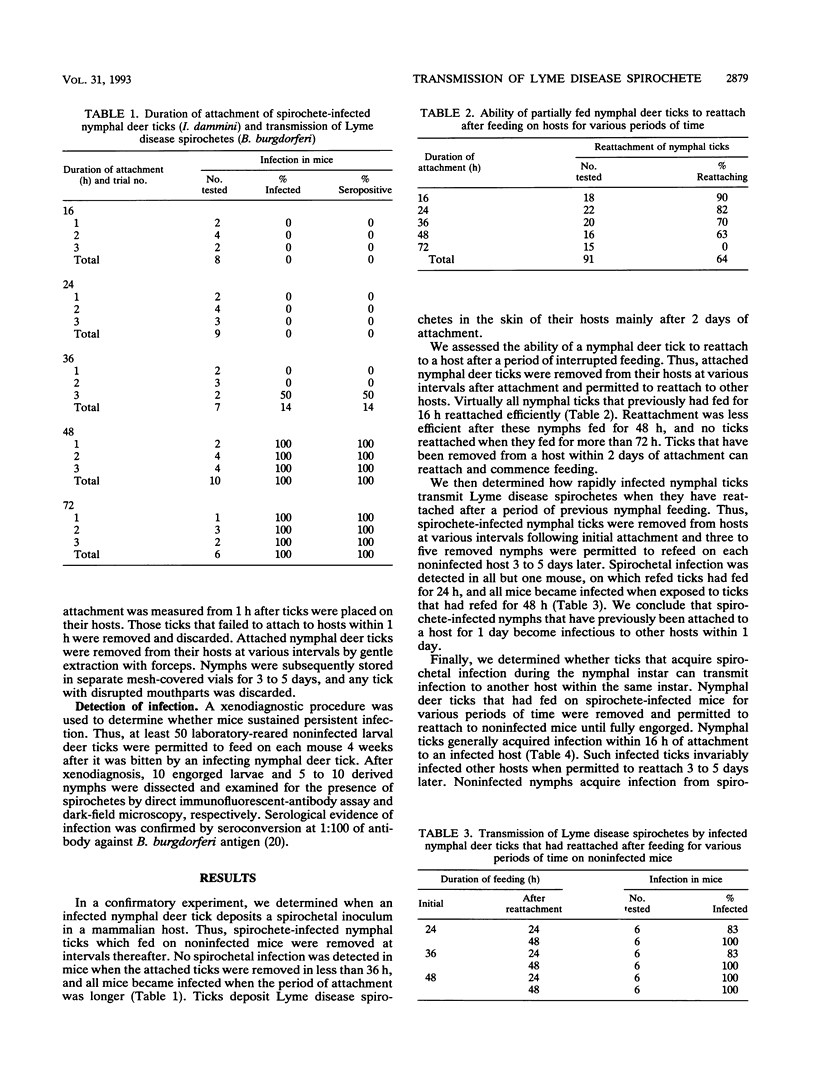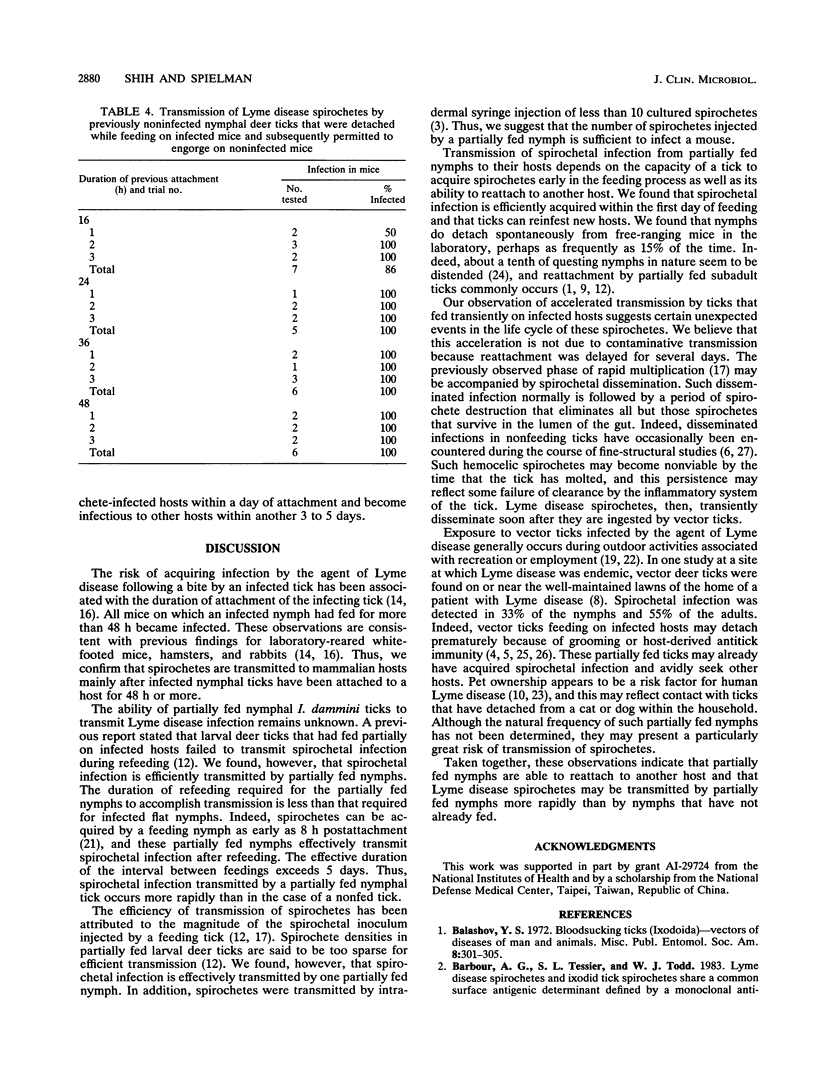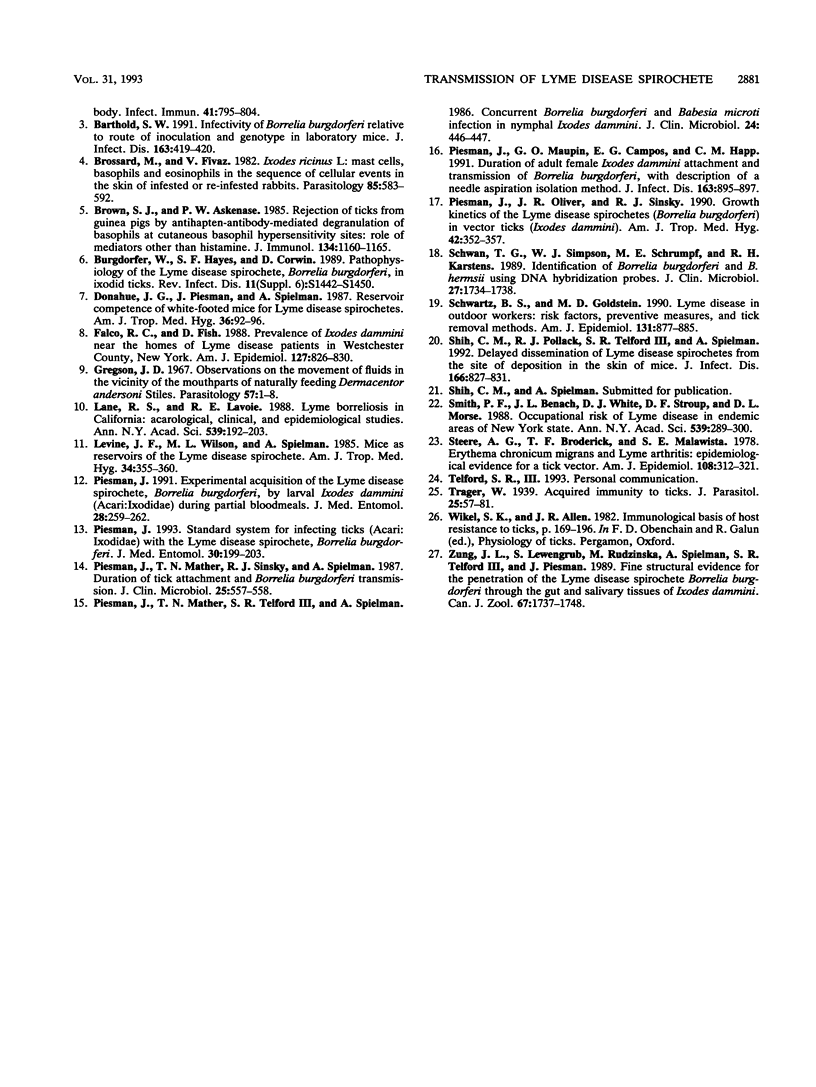Abstract
To determine how rapidly Lyme disease spirochetes (Borrelia burgdorferi) can be transmitted by partially fed vector ticks (Ixodes dammini), attached nymphs were removed from their hosts at various intervals post-attachment and subsequently permitted to re-feed to repletion on noninfected mice. We confirm previous reports that ticks deposit Lyme disease spirochetes in the skin of their hosts mainly after 2 days of attachment. Those that have been removed from a host within this interval can reattach and commence feeding. Spirochete-infected nymphs that have previously been attached to a host for 1 day become infectious to other hosts within another day. Noninfected nymphs acquire infection from spirochete-infected hosts within a day of attachment and become infectious to other hosts 3 to 5 days later. Virtually all ticks transmitted infection when reattaching after first feeding for 2 days. We conclude that partially fed nymphal ticks transmit spirochetal infection more rapidly than do ticks that have never been attached to a host and that infected ticks become infectious before they molt.
Full text
PDF



Selected References
These references are in PubMed. This may not be the complete list of references from this article.
- Barbour A. G., Tessier S. L., Todd W. J. Lyme disease spirochetes and ixodid tick spirochetes share a common surface antigenic determinant defined by a monoclonal antibody. Infect Immun. 1983 Aug;41(2):795–804. doi: 10.1128/iai.41.2.795-804.1983. [DOI] [PMC free article] [PubMed] [Google Scholar]
- Barthold S. W. Infectivity of Borrelia burgdorferi relative to route of inoculation and genotype in laboratory mice. J Infect Dis. 1991 Feb;163(2):419–420. doi: 10.1093/infdis/163.2.419. [DOI] [PubMed] [Google Scholar]
- Brossard M., Fivaz V. Ixodes ricinus L.: mast cells, basophils and eosinophils in the sequence of cellular events in the skin of infested or re-infested rabbits. Parasitology. 1982 Dec;85(Pt 3):583–592. doi: 10.1017/s0031182000056365. [DOI] [PubMed] [Google Scholar]
- Brown S. J., Askenase P. W. Rejection of ticks from guinea pigs by anti-hapten-antibody-mediated degranulation of basophils at cutaneous basophil hypersensitivity sites: role of mediators other than histamine. J Immunol. 1985 Feb;134(2):1160–1165. [PubMed] [Google Scholar]
- Burgdorfer W., Hayes S. F., Corwin D. Pathophysiology of the Lyme disease spirochete, Borrelia burgdorferi, in ixodid ticks. Rev Infect Dis. 1989 Sep-Oct;11 (Suppl 6):S1442–S1450. doi: 10.1093/clinids/11.supplement_6.s1442. [DOI] [PubMed] [Google Scholar]
- Donahue J. G., Piesman J., Spielman A. Reservoir competence of white-footed mice for Lyme disease spirochetes. Am J Trop Med Hyg. 1987 Jan;36(1):92–96. doi: 10.4269/ajtmh.1987.36.92. [DOI] [PubMed] [Google Scholar]
- Falco R. C., Fish D. Prevalence of Ixodes dammini near the homes of Lyme disease patients in Westchester County, New York. Am J Epidemiol. 1988 Apr;127(4):826–830. doi: 10.1093/oxfordjournals.aje.a114865. [DOI] [PubMed] [Google Scholar]
- Lane R. S., Lavoie P. E. Lyme borreliosis in California. Acarological, clinical, and epidemiological studies. Ann N Y Acad Sci. 1988;539:192–203. doi: 10.1111/j.1749-6632.1988.tb31853.x. [DOI] [PubMed] [Google Scholar]
- Levine J. F., Wilson M. L., Spielman A. Mice as reservoirs of the Lyme disease spirochete. Am J Trop Med Hyg. 1985 Mar;34(2):355–360. doi: 10.4269/ajtmh.1985.34.355. [DOI] [PubMed] [Google Scholar]
- Piesman J. Experimental acquisition of the Lyme disease spirochete, Borrelia burgdorferi, by larval Ixodes dammini (Acari: Ixodidae) during partial blood meals. J Med Entomol. 1991 Mar;28(2):259–262. doi: 10.1093/jmedent/28.2.259. [DOI] [PubMed] [Google Scholar]
- Piesman J., Mather T. N., Sinsky R. J., Spielman A. Duration of tick attachment and Borrelia burgdorferi transmission. J Clin Microbiol. 1987 Mar;25(3):557–558. doi: 10.1128/jcm.25.3.557-558.1987. [DOI] [PMC free article] [PubMed] [Google Scholar]
- Piesman J., Mather T. N., Telford S. R., 3rd, Spielman A. Concurrent Borrelia burgdorferi and Babesia microti infection in nymphal Ixodes dammini. J Clin Microbiol. 1986 Sep;24(3):446–447. doi: 10.1128/jcm.24.3.446-447.1986. [DOI] [PMC free article] [PubMed] [Google Scholar]
- Piesman J., Maupin G. O., Campos E. G., Happ C. M. Duration of adult female Ixodes dammini attachment and transmission of Borrelia burgdorferi, with description of a needle aspiration isolation method. J Infect Dis. 1991 Apr;163(4):895–897. doi: 10.1093/infdis/163.4.895. [DOI] [PubMed] [Google Scholar]
- Piesman J., Oliver J. R., Sinsky R. J. Growth kinetics of the Lyme disease spirochete (Borrelia burgdorferi) in vector ticks (Ixodes dammini). Am J Trop Med Hyg. 1990 Apr;42(4):352–357. doi: 10.4269/ajtmh.1990.42.352. [DOI] [PubMed] [Google Scholar]
- Piesman J. Standard system for infecting ticks (Acari: Ixodidae) with the Lyme disease spirochete, Borrelia burgdorferi. J Med Entomol. 1993 Jan;30(1):199–203. doi: 10.1093/jmedent/30.1.199. [DOI] [PubMed] [Google Scholar]
- Schwan T. G., Simpson W. J., Schrumpf M. E., Karstens R. H. Identification of Borrelia burgdorferi and B. hermsii using DNA hybridization probes. J Clin Microbiol. 1989 Aug;27(8):1734–1738. doi: 10.1128/jcm.27.8.1734-1738.1989. [DOI] [PMC free article] [PubMed] [Google Scholar]
- Schwartz B. S., Goldstein M. D. Lyme disease in outdoor workers: risk factors, preventive measures, and tick removal methods. Am J Epidemiol. 1990 May;131(5):877–885. doi: 10.1093/oxfordjournals.aje.a115578. [DOI] [PubMed] [Google Scholar]
- Shih C. M., Pollack R. J., Telford S. R., 3rd, Spielman A. Delayed dissemination of Lyme disease spirochetes from the site of deposition in the skin of mice. J Infect Dis. 1992 Oct;166(4):827–831. doi: 10.1093/infdis/166.4.827. [DOI] [PubMed] [Google Scholar]
- Smith P. F., Benach J. L., White D. J., Stroup D. F., Morse D. L. Occupational risk of Lyme disease in endemic areas of New York State. Ann N Y Acad Sci. 1988;539:289–301. doi: 10.1111/j.1749-6632.1988.tb31863.x. [DOI] [PubMed] [Google Scholar]
- Steere A. C., Broderick T. F., Malawista S. E. Erythema chronicum migrans and Lyme arthritis: epidemiologic evidence for a tick vector. Am J Epidemiol. 1978 Oct;108(4):312–321. doi: 10.1093/oxfordjournals.aje.a112625. [DOI] [PubMed] [Google Scholar]


